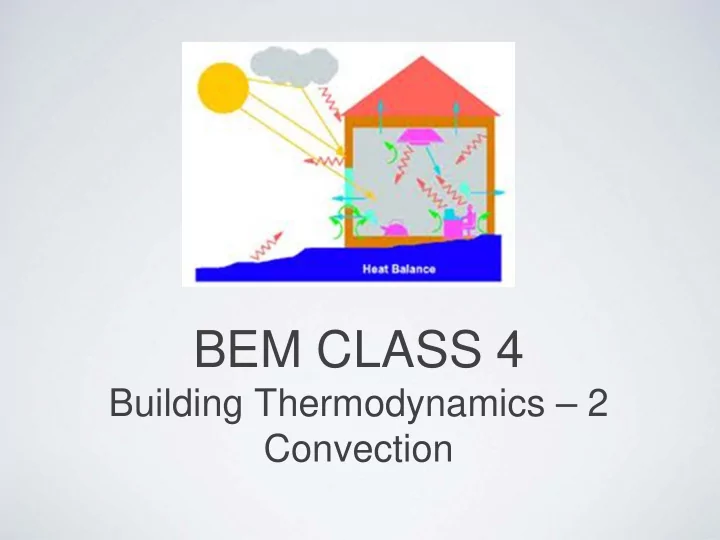

BEM CLASS 4 Building Thermodynamics – 2 Convection
Overall class review • Discussion - Where are we? What does BEM do? What is it good for? • Conduction discussion – does it matter whether insulation is on the inside or outside of a masonry building? • Housekeeping - engineers & architects. Lab teams. Project teams.
Forms of Heat Transfer Conduction Convection Radiation
CONVECTIVE EFFECTS • Effect on conduction (surface effects) • Air movement into and out of buildings • Latent heat in outside air • Interior air flows and comfort
AIR MOVEMENT INTO & OUT OF BUILDINGS • Wind and Stack effects • Variable impacts • CFD • Ventilation exhaust • Supply air & building pressurization
HOW MUCH OUTSIDE AIR? • All-natural draft ventilation • Function of wind, draft and openings • estimation by crack-length or by air-changes per hour. • 0.5 - 2 ACH • Mechanically-driven systems • Count up CFM from fan ratings • Code for ventilation • NYC Building Code. • ASHRAE 62.1 • "15 CFM PER PERSON "
HOW MUCH OUTSIDE AIR? • ASHRAE 62.1 – NOT SO SIMPLE
HOW MUCH HEATING LOAD? • Let’s look at heating only • Infiltration/ventilation can be 50% or more of building heat load dT
Overall Building Heat Loss Exercise A 50’ x 150’ x 10 story free-standing building has an overall R- value of 3 (taking into account all walls, windows, roof). Each story is 10’ tall. Ventilation, as calculated at 15 cfm per occupant at design occupancy, provides .85 air-change per hour. Ignore basement/foundation losses. Calculate the design heat load at 10 dF outside temperature and 70 dF indoor temperature
[(50 x 2) + (150 x 2)] x 10 x 10 = 40,000 sf surface area 40,000 x 1/3 x (70-10) = 800,000 BTUH conduction 50 x 150 x 10 x 10 = 750,000 cf volume 750,000 x .85 x .018 x (70-10) = 688, 500 BTUH ventilation Answer = 800,000 + 688,500 = 1,488,500 BTU
LATENT HEAT LOAD • Humidity in hot air. Enthalpy. • Psychrometric chart.
LATENT HEAT LOAD From Tao & Janis Mechanical and Electrical Systems in Buildings
Exercise It is a 90 dF, 70% RH day outside. You want to deliver air at 65 dF, 50% RH. On the psychrometric chart describe the work that has to be done at the air-handling unit and coils, showing lines for sensible cooling, latent heat removal and re-heat. sensible latent reheat
CONTROL OF OUTSIDE AIR • Fans off at night? OA dampers closed? • "Minimum Outside Air" - fix to code based on full occupancy • Economizer mode - use max OA when conditions are suitable • Dynamic Ventilation Control - CO2 - match OA to occupancy
INTERIOR AIR FLOWS • HVAC “throw and spread". • Coanda effect. • Short-circuits. • Stratification. • "droop" at low flows in variable volume systems. • Mixing vs Displacement • Use of CFD. • What is the response to comfort complaints?
Recommend
More recommend